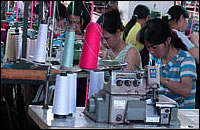Textiles Industry: China Thrives as We Watch

 |
| A clothing factory in China |
Although we may attribute China’s textile industry growth to its modern machinery and easy financing,we need to ask: Did China begin with modern machinery? Was the Chinese government aware of the potential in its textile industry? Do African governments invest in long-term projects? Answers to these questions may help us understand why China thrives as we watch.
No industrialised country in the world started with all infrastructures in place. In the sixties, most Asian nations (like Malaysia and Singapore) were at par with several African countries. They however resolved to invest heavily in their areas of strength – the textiles industry. Thirty years later, they had produced enough for their local demands and had begun developing export markets. Having developed cheaper production processes, they did not have to do much in rendering their African competitors irrelevant.
This phenomenon forced the government of Kenya to liberalise the industry and subsequent garment importation.The country could not have done any better, after all, even with the initial monopoly status, the country was only producing natural textiles (From animals and plants) while artificial textiles were also on demand locally.
Since the sector could only meet 45% of the local textile demand, the deficit 55% needed supplementary producers for the industry to run smoothly. The management running the industry at the time did not have a touch of the global trends in the sector and therefore could not make informed decisions. China enjoyed a bird’s eye view of global needs.
The Chinese government went ahead to heavily subsidise farm inputs for cotton farmers thereby reducing their production costs. They then invested in ginnery, milling and other high speed production machinery. Having seen a deficit in artificial textiles, India and Pakistan threw their muscles behind mass production, finer quality, better design and unique dyeing techniques. By the year 2000, Africa’s textile industry had been hit well enough to be a candidate for the grave.
To act a resuscitator role was the US with its AGOA (Africa Growth Opportunity Act) that aims at extending preferential access for imports from beneficiary Sub-Saharan African countries until September 30, 2015. The AGOA initiative is meant to help less developed countries improve their production capacities and understand the intricacies of the industry. Being a beneficiary, Kenya set up EPZs (Export Processing Zones) under the AGOA Act, providing employment to locals except that all products including spoils are taken to the US.
Local farmers and governments may try to revive the industry, but it will need a double effort than it would have been in the 1960’s or 70’s. According to Times Research, an acre of cotton farmland in the US attracts a subsidy of $230. In December, 2004, the textiles and clothing quota by the major importers ( United States and Europe) ceased. This left the trade to be governed by the World Trade Organisation rules.
Chinese government boosts the country’s production therefore achieving the lowest prices and pushing developing countries out of competition. For instance, a pair of shoes costing Kenyan firm $ 10 in production could retail at $ 15 on the local market. The same shoe can be produced in China at an average of $ 2 and retailed at $ 5 on the local market. While our local producer gets a 50% profit, the Chinese pockets a whopping 150% yet he sells the item three-times cheaper.
Clothing production is even shocking. The textile industry in China has developed so much that in a minute, it manufactures an average of five jean trousers. The same item takes an average of three hours to produce in ‘efficient’ industries in Africa. While the disparity is not wide, the Chinese trouser will retail at a price three times cheaper the ‘Made in Africa’ one.
Whereas we may blame it on anything…at the end of it all, we are to blame. We slept when everyone was awake.For those who have woken up, it is time for re-invention and focussing on our strength. Offering subsidies to ‘fiber-plants’ farmers is one step ahead; training them on proper farming methods is another. Extensive research to assess the viability of the industry in the next ten years may not only help us understand where we are headed, but also determine the value of investment we need to put in the sector.
Creation of dedicated complementary industries to utilise the raw material and the fabrics produced into garments should be a priority. Aggressive marketing should back the same thereby initiating local purchasing power before venturing into exports. Who knows, an acceptance at home might spark a calling from abroad.
